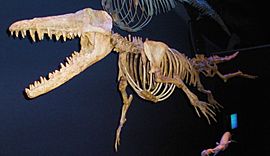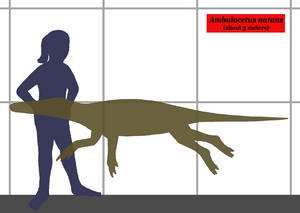Ambulocetus facts for kids
Quick facts for kids AmbulocetusTemporal range: Lower Eocene
|
|
|---|---|
 |
|
| Scientific classification | |
| Kingdom: | |
| Phylum: | |
| Class: | |
| Order: | |
| Suborder: | |
| Family: |
Ambulocetidae
|
| Subfamily: |
Ambulocetinae
|
| Genus: |
Ambulocetus
|
| Binomial name | |
| Ambulocetus natans Thewissen et al., 1996
|
|
Ambulocetus means "walking whale". It was an early type of whale that could live both on land and in water. This animal, called Ambulocetus natans, lived about 50 to 48 million years ago. Scientists have found its fossils in Pakistan. Back then, Pakistan was a coastal area of India, which was a big island in the Indian Ocean.
Contents
What Was Ambulocetus Like?
Ambulocetus looked a bit like a big crocodile. It was about 3 meters (10 feet) long. Its body was built for both land and water.
Its back legs were better for swimming than for walking. It probably swam by moving its back up and down. This is similar to how otters and modern whales swim.
How Did Ambulocetus Hunt?
Ambulocetus might have hunted like crocodiles. It would wait in shallow water to catch animals that came too close. Scientists studied its teeth. They found that Ambulocetus could live in both salty ocean water and fresh river water.
Ambulocetus did not have outer ears like humans. To find prey on land, it might have put its head on the ground. This way, it could feel vibrations from animals moving nearby.
Why Is Ambulocetus an Early Whale?
Scientists believe Ambulocetus is an early whale. It has special features that modern whales also have. For example, it had a special nose that let it swallow food underwater.
Its ear bones were also like those of whales. This helped it hear well when it was underwater. Also, its teeth are very similar to other early whales.
Where Were Fossils Found?
Scientists have found several skeletons of Ambulocetus. One nearly complete skeleton was discovered. Other partial skeletons have also been found. All of these fossils were found in Pakistan.
Related pages
Images for kids
-
Reconstructed skeletons of Ambulocetus (right) and Cynthiacetus (left) at the Muséum national d'histoire naturelle, Paris
-
Reconstructed Ambulocetus skeleton at the Canadian Museum of Nature, Ottawa
-
The hindlimb (back leg) of Ambulocetus at the Muséum national d'histoire naturelle, Paris
-
Ambulocetus may have swum like otters (above: a giant otter swimming at Tierpark Hagenbeck)
See also
 In Spanish: Ambulocetus para niños
In Spanish: Ambulocetus para niños











